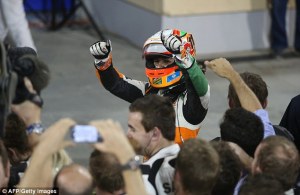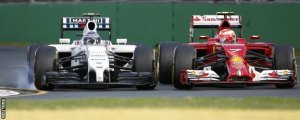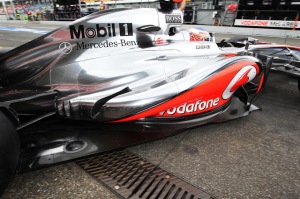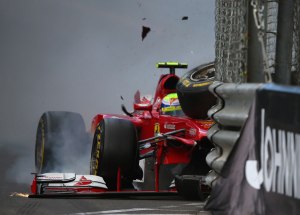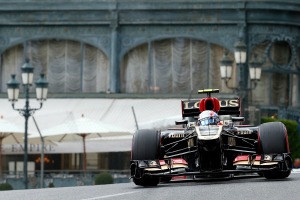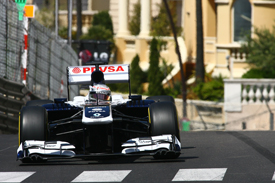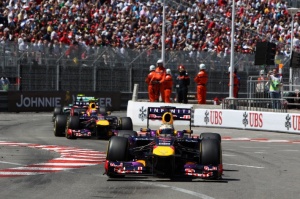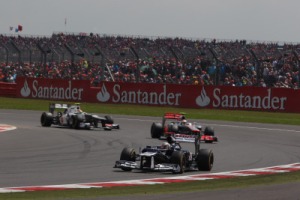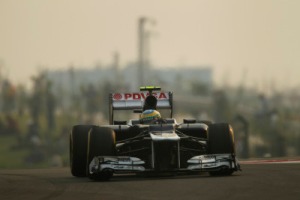After two easy victories, one for each of the Mercedes drivers, in the opening two races of the season many were writing off Formula 1. Quieter engines, fuel efficiency and the same big margins of victory; no battles at the front – F1 had lost the plot, right? Wrong. The Bahrain grand prix was full of thrills and spills and featured a titanic battle for victory between the Mercedes drivers – easily the best race in recent years; a real thriller that had you on the edge of your seat right until the chequered flag.
In the end, just like a week ago in Malaysia, it was Lewis Hamilton that came out on top in Bahrain, although his margin of victory over team-mate Nico Rosberg was dramatically reduced from 17.3 seconds last time out to a whisker over a single second this time. As reflected by the narrow margin of victory, we had a real fight between the Mercedes drivers in Bahrain, not only in the final grandstand finish over the last 10 laps, but also, crucially, in the run up to the first round of pit stops.
Unlike in the last two races, in Bahrain Rosberg beat Hamilton in qualifying to take his first pole position of the season, with his team-mate qualifying second, giving the Silver Arrows their first front row lock-out of the season. Rosberg had clearly raised his game after being dominated by Hamilton at Sepang and looked to have the edge over the 2008 world drivers’ champion this time. The German, the race winner in Australia, might have been able to streak clear in the same way that Hamilton managed in Malaysia, but he was beaten off the line, and into turn one, by his team-mate.
Having gotten the drop on Rosberg, Hamilton couldn’t pull away, though. The gap hovered around a second to a second and a half in the opening stint of the race allowing our first round of fireworks to take place as we approached the first pit stops. Knowing that the driver who stopped first would enjoy the advantage of the undercut – the advantage of fresher tyres for a lap or so – Rosberg pushed hard to overtake Hamilton and closed to within DRS range of his team-mate.
On lap 18 Rosberg made his move, diving down the inside of Hamilton at turn one before conceding the lead again as the Englishman fought back. On the next lap Rosberg tried again. This time it looked like he might have made the pass stick, but Hamilton wasn’t giving up and re-passed Rosberg into turn four. It was a truly brilliant counter-attack from Hamilton and it looked critical as at the end of the lap he made his pit stop. He had secured the advantage of the undercut.
Once both of the Mercedes drivers had stopped – Hamilton for another set of option tyres, while Rosberg had switched to primes – things seemed to settle down. The undercut had given Hamilton a six second advantage, which steadily increased eventually reaching 9.7 seconds on lap 40. While it was never quite a case of ‘race over’ given that Hamilton would use the slower prime tyre in the final stint while Rosberg would use the faster options, things did look reasonably comfortable up front.
But then along came Pastor Maldonado in the Lotus. On lap 41 the Venezuelan exited the pits and T-boned Esteban Gutierrez’s Sauber, launching the Mexican’s car into a somersault at turn one – an incident which resulted in Maldonado receiving a five place grid penalty after the race, plus three points on his super-licence. Unsurprisingly, out came the safety car and away went Hamilton’s lead.
With Hamilton now on the slower tyres and Rosberg on the faster options, it looked to be advantage Rosberg. Just before the safety car pulled in with 10 laps to go, though, both Mercedes drivers received identical radio messages from Mercedes technical director Paddy Lowe “With 10 laps left to race, can we just make sure we bring both cars home.” Team orders, I thought. I was wrong! Rosberg attacked Hamilton immediately and while he couldn’t get the pass done he stayed close enough to Hamilton to receive the advantage of DRS when it became available two laps after the re-start.
Rosberg attacked again on laps 52 and 53, squeezing ahead of Hamilton only to be swiftly re-passed by his team-mate. It was thrilling stuff, but with better tyres and the edge in terms of outright speed I thought it was only a matter of time before Rosberg made the move stick. I was wrong again! Hamilton was told that he could use the overtake button on the exit of corners to aid in his defence and he was able to pull out a gap of around a second to Rosberg in the final couple of laps.
The second display of on-track fireworks between the Mercedes drivers was finally over as Hamilton took a brilliant victory, different in so many different ways to the win just a week earlier at Sepang. I haven’t even mentioned the other brilliant battles throughout the field during the race. Sergio Perez claimed third place to give Force India only their second ever podium finish and we saw on track fireworks from a whole host of other drivers. It was a tremendous race and a brilliant advert for the new era of Formula 1.
Not only did the battle between the Silver Arrows prove a thrilling spectacle, it also finally showed us the extent of the pace that the Brackley-based team have in their pocket. In just 10 laps they built up a 24 second advantage over Perez in third place; an advantage of some 2.4 seconds per lap. Something that will surely send shivers down the spines of the rest of the paddock.
The championships look like Mercedes’s to lose, but we’re highly unlikely to get the sort of cakewalk that we’ve seen at times from Red Bull and Sebastian Vettel in recent seasons. The Mercedes drivers seem pretty closely matched and the team seem determined to let them race. That’s great for the sport. While Hamilton has two victories to Rosberg’s one, it’s the German that so far holds the championship advantage thanks to Hamilton’s unfortunate retirement in Australia.
There were more fireworks after the race, this time in the night sky as the organisers brought the curtain down on the 900th grand prix and the 10th at the Sakhir circuit. The next race in China has a lot to live up to.



